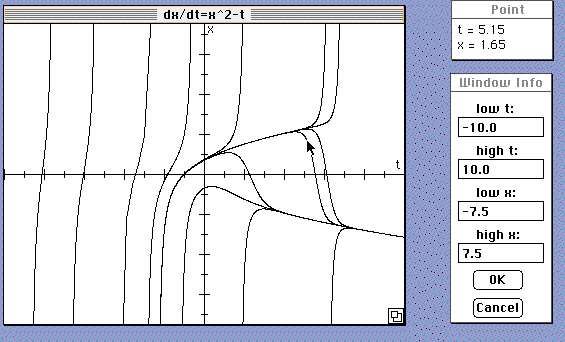DiffEq Support Notes
DiffEq is one of the dynamical systems exploration tools in MacMath
9.2. MacMath 9.2 was developed
locally by Professor John Hubbard and Beverly West, and has been commerically
sold by Springer Verlag.
It specializes in exploring 1 dimensional (non-autonomous) differential
equations dx/dt=f(x,t).
Related programs include DiffEq, Phase Plane and DiffEq,
3D Views which specialize respectively
in the two and three dimensional cases. By appending an equation like
dy/dt=1,
the two dimensional
programs can also be utilized to study many aspects of one dimensional
equations such as those entered in DiffEq.
The program Planar Systems in MacMath 9.6 is an incomplete
update
of DiffEq, Phase Plane, with
many nice additional features but incomplete support for basics like
printing.

Basic operation
of the program involves entering an equation and then
clicking at various locations to
see the trajectories going through those points. By default trajectories
first continue forward until a window
boundary is encountered. Then a trajectory backwards (negative
time) from the intial point is traced. Clicking
the mouse while a trajectory segment is being traversed terminates
that direction of traversal immediately.
DiffEq gives very rich graphical displays but has no support for
providing large amounts of numerical data.
Some Frequently Asked Questions
-
Axes and Tickmarks
-
are added from the Settings menu.
-
Equations
-
are also changed from below the Change menu.
-
Numerical Integration
-
methods available under the Change menu are Euler, Heun (midpoint
Euler) , and Runge-Kutta.
-
The Point Window
-
contains the coordinates where the mouse was last clicked.
-
Rescaling
-
operations may require a carriage return to take effect.
-
Slope Marks
-
are available from the Settings menu. The program Planar Systems
is notable for improving the algorithm used in drawing these.
-
Step Sizes
-
by default are very large because the program was written many years ago.
Choose something smaller
-
from below the Change menu.
-
Special Functions Supported include
-
Option-p for pi.
-
abs(), sqrt(), sgn(), ln(), exp(), atan(),
and floor().
-
^ is exponentiation.
-
Zooming
-
is accomplished by selecting Blow Up fromt the Task menu
and then selecting a rectangle while holding down the mouse button.
-
Location
In the folder MacMath 9.2 toplevel on all Macintoshes in the lab.
Printing
Most MacMath programs have some difficulty printing in the lab. Screen
Dumps should always be viewed
as the backup technique when difficulties are encountered. Turning
background printing off may also help
this program.
Documentation
A manual (yellow) for MacMath 9.2 is available in the lab bookcase.